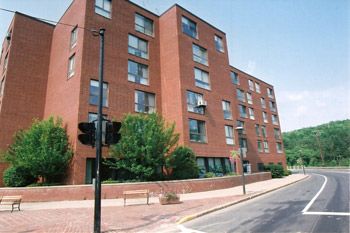Housing bloom: Stanford Management makes its mark as an affordable provider
When Rosa Scarcelli became president of Stanford Management in 2005, she had to get her hands dirty. Functions at the affordable housing provider, like rent collection and application screening, were siloed, and delinquency rates were inching up. So, Scarcelli went over the business with a fine-toothed comb. She set out to establish a new culture geared toward high-quality service and instituted changes from replacing key corporate staffers to renegotiating cell phone contracts. Now, she’s getting her hands dirty again, packing up boxes to move her expanding Portland business into roomier environs.
Stanford Management now manages 58 properties in Maine and another 24 in Pennsylvania, Mississippi and Connecticut. With the company’s latest management contract acquisition — the Munjoy South complex overlooking Casco Bay — it oversees housing for more than 5,000 residents in the state. At 140 units, the Munjoy contract is by far the company’s largest, but hardly its mainstay. Smaller rural developments, stretching from Madawaska to Old Orchard Beach to Farmington, make up the bulk of its $166 million Maine portfolio. Scarcelli, who assumed ownership of the company in 2007, now has set her sights on becoming the largest affordable housing provider in the United States within a decade. “There’s a great opportunity to bring high-quality service to the housing management industry,” she says. While developers labor to find financing for new projects, the management side of the affordable housing sector is holding its own, Scarcelli says. “People are actually being pushed toward our housing stock.”
Time for renovations
Stanford manages a portfolio in all four states valued at $253 million. In Maine, it manages properties for two major owner-developers, Liberty Group and Gleichman and Co. Scarcelli has a significant ownership stake in a third, limited partner, GN Holdings. That investment, however, is separate from the management company, she says.
While Scarcelli is making her name in the Portland housing scene, the Gleichman moniker rings a few bells around town. Pam Gleichman, Scarcelli’s mother, formerly owned Stanford, as well as Landmark America LLC, another real estate company that garnered headlines for some high-profile developments. Gleichman was credited for restoring the Lafayette Square hotel in the city’s downtown, but in 1999 was ordered by a judge to temporarily relinquish control of the project after she was sued by the Maine State Housing Authority. The authority alleged that she defaulted on a $3.3 million loan for the project, according to news reports. Gleichman later repaid the balance. In 1995, she was suspended from federal assistance programs for failing to live up to contractual obligations. Still, she was recognized for her skill at obtaining federal and state money, restoring public buildings and innovating in the affordable housing industry, according to news reports.
When Scarcelli, 39, took over Stanford, it was time to put her own stamp on the company, she says. “Hired guns” from a large national outfit, Aimco, were running the business and placed little priority on the relatively small Stanford portfolio, Scarcelli says. “It needed to be turned around,” she says. An art history major at Bowdoin College, she reveled in using her creative energies to find efficiencies and revamp policies. She rebid with all the company’s vendors, solicited new insurance quotes, restructured policies and automated forms. Scarcelli recalls the opportunity gratefully and almost wistfully, calling it the most enjoyable part of her career. The fruits of her effort were born quickly, with all of the portfolios performing well within a year and employees excited about a new culture, Scarcelli says. “I really think being in this business takes many sides of your brain,” she says from her office, where an expansive mixed media canvas of paint and newsprint hangs on the wall. “It’s very creative and you’ve got to be innovative.” The average occupancy rate is 98% and delinquencies are nearly nonexistent today. “She has done what she said she would do,” Dale McCormick, director of the Maine State Housing Authority, now known as MaineHousing, says of Scarcelli and her company’s contract management. “We like that in a manager.”
Stanford in 2006 secured $25.5 million in USDA Rural Development funds to preserve and revitalize 20 multifamily housing properties, more than 20% of the 78 properties nationwide that received assistance that year, according to the state Rural Development office. The next year, the company was recognized by Affordable Housing Finance magazine among the top 10 companies completing acquisitions nationwide. In Scarcelli’s office, a tower of black file cabinets labeled with Stanford properties lines the wall. Despite its success, the company’s not in it for lavish profits. Federal subsidy makes up about 70% of a typical project’s budget. Revenue from rent, which residents pay at 30% of their total income, makes up the remainder. “It’s a low-margin business,” Scarcelli says. “It’s not a business where you’re making a lot of money.”
Filling a vacancy
The affordable housing market has historically performed better than other real estate sectors during lean economic times, because government subsidies are available, cash-strapped tenants look for cheaper options and property and building costs drop. These days, however, developers struggle to line up financing for even promising projects. Affordable housing providers, on the other hand, are holding steady, according to Susan Michaud-Bosse, president of the Maine Real Estate Managers Association. As managers of market-rate apartments struggle with unpaid rent and evictions tied to rising unemployment, waitlists for cheaper housing grow longer, she says. “There’s a lot more people looking for affordable housing.” Among the largest challenges is a weak market for tax credits as developers shy away from putting up money for new projects. The credits are designed to encourage private equity development of low-income housing, but aren’t always enough to offset a tight credit market. Scarcelli said she plans to continue to focus on housing management and has no interest in widening the company’s scope to include development, an entirely different business.
The Maine Real Estate Managers Association is lobbying to funnel some of the nearly $100 million in stimulus funding for weatherization — which appears targeted to single-family homes — to multifamily housing, Michaud-Bosse says. Some of the stimulus money will fund existing Section 8 housing to prevent shortfalls in those contracts, she says. On the state level, newly proposed green housing legislation would allow the state to borrow $200 million over 10 years to fund new and existing affordable housing for low-income and elderly residents. Sponsored by Senate President Elizabeth Mitchell, former director of the Maine State Housing Authority, LD 774 would take $7.5 million in real estate transfer tax monies from the General Fund and direct it to the Maine Energy, Housing and Economic Recovery Program. According to an economic impact study on the legislation conducted by the Maine Center for Business and Economic Research at the University of Southern Maine, the bill would create or maintain 5,800 jobs in Maine each year in 2010 and 2011. The bulk of the money, nearly $500 million, would fund construction, renovations and weatherization efforts, the study says. The bill has met with opposition among some Republicans who are skeptical of introducing a new program as the appropriations committee struggles to develop a two-year state budget.
According to a study commissioned by the Maine Affordable Housing Coalition, more than 86,000 low-income households in Maine — or 15% of all owners and renters — have “severe housing affordability problems.” Those households earn less than 80% of the area median income and pay more than 50% of their income for housing costs, the study states. As housing values and rents increase, income is failing to keep pace, the study found. Between 2000 and 2006, home values rose 70% and rents 31%, while household incomes have climbed only 16%. And renters appear to have it particularly tough. Nearly half of Maine’s 330,000 single-family home owners earn over 120% of the federal median income. Of the 148,500 renter households, almost half earn less than 50% of the area median income. The study also identified the elderly as particularly at risk.
Seniors and the disabled are well represented in Stanford’s clientele. High-quality management sets the company and its 150 employees apart and will continue as its focus, Scarcelli says. Her 16 property managers in Maine handle everything from screening applicants to rent collection to invoice processing. Employees also coordinate social services for residents. “We’re very hands-on, we’re very present,” Scarcelli says. Property manager Charlene Spadea has worked for the company since 1989, when she started as a cleaning person. She now manages three properties with 73 units in Dixfield and Turner. Spadea left the company briefly in December 2007, but came back several weeks later, to open arms. “It’s a great company to work for,” she says. “They work with you.”
Scarcelli, of Wilton, joined the family business at the age of 22 after graduating from Bowdoin and finding few other job prospects. From then on, she held a series of high-level positions, including running a development division from 1994 to 1999. “I’ve learned on the job. That’s my MBA,” she says.
Her skill at forging public-private partnerships recently earned her recognition as Maine’s first “Emerging Leader” by the Aspen Institute’s 2009 Crown Fellowship. The prestigious honor, awarded to a class of 21 entrepreneurs under age 45 nationwide, is designed to “engage the next generation of leaders in the challenge of community-spirited leadership,” according to a press release. It requires that awardees have achieved “conspicuous success in their chosen fields and are at a point of inflection in their lives and careers.” Other winners this year include best-selling author Timothy Ferris and a senior policy advisor to President Obama. A photo of Scarcelli with the president hangs in her front office. It’s sure to be among the files, furniture and other items packed up for the move to the company’s new office in the Drummond Woodsum building on Marginal Way. Framed renderings of its properties in the entrance hallway will find a home at the expanding Stanford. And if all goes according to plan, so will people all over the country.
Jackie Farwell, Mainebiz staff reporter, can be reached at jfarwell@mainebiz.biz.












Comments